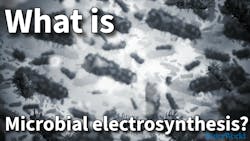What is microbial electrosynthesis?
Microbial electrosynthesis (MES) is a process in which microorganisms use electricity to convert carbon dioxide (CO2) into useful chemicals or fuels. MES provides a novel route for the generation of valuable products from things like water and wastewater. This process combines multiple disciplines, from microbiology to electrochemistry and renewable energy.
This emerging technology is being used as a CO2 sequestration method to address climate change. MES is able to convert CO2 from pollution or waste into various carbon compounds.
Key concepts of microbial electrosynthesis (MES)
Key concepts of MES include:
- Microbes: Electrogenic bacteria, or electroactive bacteria (EAB), can transfer electrons to electrodes, allowing them to reduce CO2. Certain microorganisms can interact directly with electrodes.
- Carbon fixation: MES systems focus on converting CO2 into various carbon compounds such as acetate, ethanol or butyrate, helping to reduce greenhouse gas emissions.
- Electrochemical process: MES supplies electricity to microorganisms via a cathode.
- Electrode potential: The process is driven by applying voltage via a cathode, making it possible to use renewable energy (solar or wind) to power the conversion.
What applications use microbial synthesis (MES)?
Applications that utilize MES include:
- Carbon capture and utilization (CCU)
- Sustainable fuel production
- Chemical synthesis
- Waste valorization (turning wastewater into valuable products)
What are some of the challenges with microbial synthesis (MES)?
While MES has shown potential, there are still challenges associated with the process including:
- Improving cathode materials
- Optimizing reactor designs
- Low efficiency and slow rates compared to chemical methods
- Need for optimized microbes and electrode materials
- Scaling and cost barrier
What are microbial biosensors?
Microbial biosensors are analytical devices that use microorganisms, such as bacteria or yeast, to detect specific substances, or analytes, in an environment. These sensors combine the biological recognition ability of microbes with a transducer that converts the microbial response into a measurable signal.
What are the key components of a microbial biosensor?
Key components of the sensors include:
- Biological recognition element: Live microbes that respond selectively to target analytes (pollutants, toxins, nutrients).
- Transducer: Converts the microbial response into a measurable signal.
- Signal processor: Amplifies and interprets the signal for display or analysis.
What are microbial biosensors used for?
The sensors are used across a variety of industries to detect pollutants. They are typically used for environmental monitoring for the detection of pollutants like heavy metals, pesticides or hydrocarbons in the soil or water. The sensors can also monitor biological oxygen demand (BOD) in wastewater.
Other applications include:
- Medical industry: Used for medical diagnostics to identify pathogens or toxins.
- Industrial process control: Used to monitor fermentation or product quality.
- Food Safety: Used to detect spoilage organisms or foodborne pathogens.
What is a microbial electrochemical system?
A microbial electrochemical system uses microorganisms to convert the chemical energy stored in biodegradable materials to direct electric current and chemicals. The systems are used to exploit the natural metabolic processes of electroactive microbes to generate electricity, drive chemical reactions or treat waste.
These systems are used for:
- Wastewater treatment
- Bioremediation
- Chemical production
- Electricity generation
- Biosensing
This article was written with the assistance of artifical intelligence.
About the Author
Alex Cossin
Associate Editor
Alex Cossin is the associate editor for Waterworld Magazine, Wastewater Digest and Stormwater Solutions, which compose the Endeavor Business Media Water Group. Cossin graduated from Kent State University in 2018 with a Bachelor of Science in Journalism. Cossin can be reached at [email protected].

